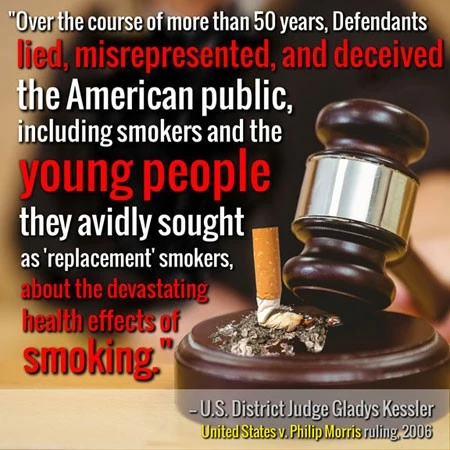On August 17, 2006, federal judge Gladys Kessler found the major tobacco companies—including Altria (Philip Morris) and RJ Reynolds—guilty on civil racketeering charges (i.e., organized criminal activity). On that day, she issued a final judgment and 1,682-page opinion that found the companies had been covering up the health risks associated with smoking and marketing their products to children for decades.
Tobacco companies were ordered in Judge Kessler's 2006 decision to issue the "corrective statements" in newspapers and on TV. After years of appeal and delay by the defendants, the ads ran in 2017 and 2018. Subsequent court decisions in 2018 also required "corrective statements" on tobacco company websites and on cigarettes packs.
Then in December 2022, a court order was issued requiring corrective statements to be posted at around 200,000 retail outlets across the country. These signs were required to be posted starting October 1, 2023 and are required to be up until June 30, 2025. The public can assist with ensuring retail stores are displaying these signs at www.tobaccosigntipline.com or via the Lung Association.
Here are 10 of the most troubling findings of fact the judge found in her ruling against these tobacco companies:
10. The tobacco companies "concealed and suppressed research data and other evidence that nicotine is addictive."
9. The tobacco companies "falsely marketed and promoted low tar/light cigarettes as less harmful than full-flavor cigarettes in order to keep people smoking and sustain corporate revenues."
8. The tobacco companies own internal records showed "that smokers switch to low tar/light cigarettes, rather than quit smoking because they believe they are less harmful."
7. The tobacco companies "recognized that smokers choose light/low tar cigarettes for a perceived health benefit defendants internally recognized that smokers rely on the claims made for low tar/light cigarettes as an excuse/ rationale for not quitting smoking."
6. Starting in the 1950s and lasting at least through 2006, different tobacco companies "at different times and using different methods, have intentionally marketed to young people under the age of twenty-one in order to recruit 'replacement smokers' to ensure the economic future of the tobacco industry."
5. The tobacco companies "youth smoking prevention programs are not designed to effectively prevent youth smoking."
4. The tobacco companies "have publicly denied what they internally acknowledged: that ETS [secondhand smoke] is hazardous to nonsmokers."
3. The tobacco companies' internal records "recognized that ETS [secondhand smoke] is hazardous to nonsmokers."
2. The tobacco companies' "marketing is a substantial contributing factor to youth smoking initiation."
1. "[This case] is about an industry, and in particular these [tobacco companies], that survives, and profits, from selling a highly addictive product which causes diseases that lead to a staggering number of deaths per year, an immeasurable amount of human suffering and economic loss, and a profound burden on our national health care system. [The tobacco companies] have known many of these facts for at least 50 years or more. Despite that knowledge, they have consistently, repeatedly and with enormous skill and sophistication, denied these facts to the public, the Government, and to the public health community."
Page last updated: January 27, 2025


